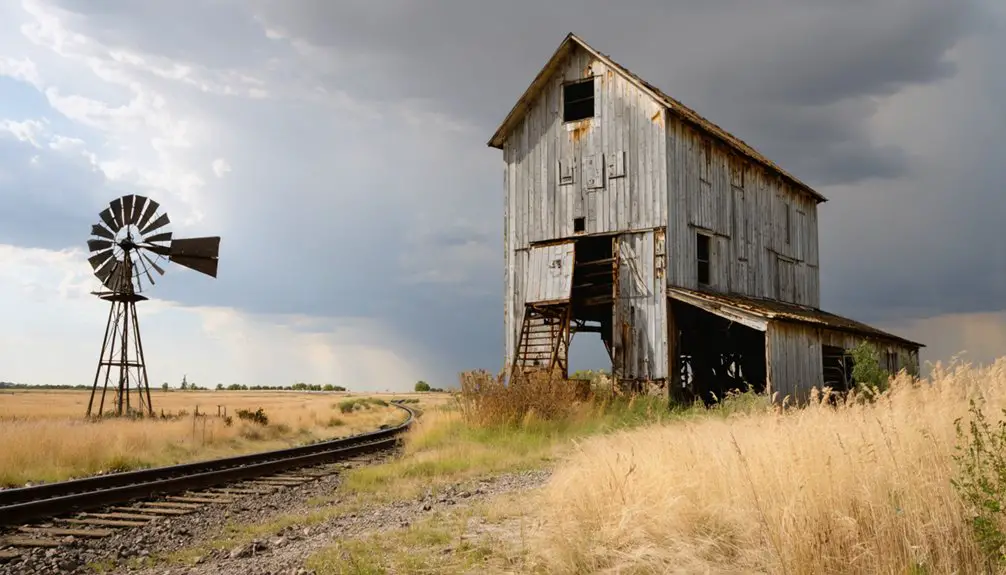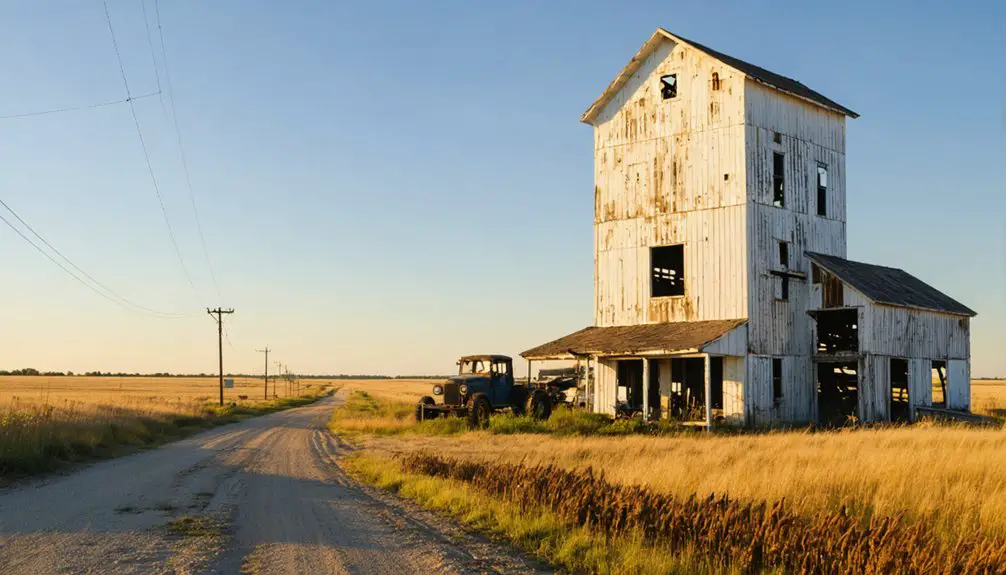You’ll discover the ghost town of Krem in North Dakota’s Mercer County, where German-Russian immigrants established a bustling prairie settlement in 1902. The town thrived as an agricultural hub with a flour mill, general stores, and vibrant cultural life until 1914, when the Northern Pacific Railroad’s decision to bypass Krem led to its decline. As residents and businesses relocated to nearby Hazen, Krem gradually faded into abandonment, leaving only cemetery stones and building foundations to tell its story.
Key Takeaways
- Krem was a German-Russian settlement in Mercer County, North Dakota that became a ghost town after being bypassed by the Northern Pacific Railroad.
- The town thrived during the Great Dakota Boom but declined when residents moved to nearby Hazen for better railroad access in 1914.
- Only remnants remain today, including the old flour mill wall, basement foundations, and two historic German-Russian cemeteries.
- Established in 1902 with Martin Netzer’s first business, Krem grew as an agricultural hub before losing its bid for county seat.
- The town’s population gradually dropped to zero by mid-century as businesses and families relocated to Hazen for economic opportunities.
From Crimea to Krem: Origins of a Prairie Settlement
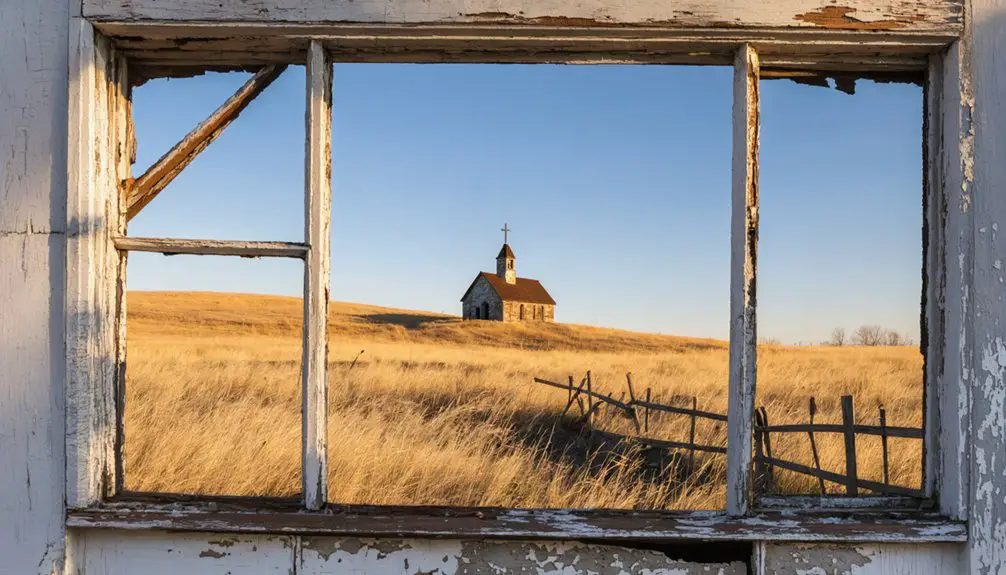
While German-Russian immigration shaped many North Dakota settlements in the early 1900s, Krem’s story uniquely begins with settlers from Crimea who established their prairie home in Mercer County.
You’ll find their cultural heritage reflected in the town’s name itself – Krem, an abbreviated form of Crimea, commemorating their ancestral homeland.
The settlement quickly grew into a trade center after Martin Netzer’s store became the first business established in 1902.
Like many towns during the Dakota Boom period, Krem’s development was accelerated by the presence of railroad expansion that connected it to larger markets.
Early Pioneers and Business Development
As pioneers streamed into North Dakota during the Great Dakota Boom of 1878-1890, Krem emerged as a bustling settlement centered around agricultural development.
You’d find early settlers facing pioneer challenges while transforming the prairie landscape, building homes from available materials like sod and local timber. Business innovations quickly followed to support the growing farming community.
Prairie pioneers overcame harsh challenges, building life from sod and timber while fostering a vibrant community through innovative farming ventures.
The settlement’s development was marked by:
- Railroad connections that brought European immigrants and enabled wheat shipments to eastern markets
- Essential businesses like supply stores, blacksmiths, and milling operations that served agricultural needs
- Trading posts that functioned as both commercial and social hubs for the growing community
Farmers claimed land through federal acts, focusing on wheat and flaxseed production while adapting to the region’s climate and soil conditions.
The County Seat Battle of 1906
Following Krem’s establishment as a major trade center, you’ll find that the town led a significant campaign in 1906 to become Mercer County’s new seat after Stanton’s courthouse burned down.
The dispute recalled the region’s history of territorial battles between competing interests dating back to the Plains Indian Wars.
Though Krem initially secured a two-thirds majority vote, county auditor Henry Sagehorn and political forces aligned with Stanton contested the results through legal challenges and vote certification tactics.
The political interference effectively blocked Krem’s victory despite its popular support, marking a vital turning point in the town’s history. This contentious battle for county representation mirrored North Dakota’s later shift from a Democratic-NPL stronghold to Republican dominance.
Election Results Controversy
The heated county seat battle of 1906 erupted after Mercer County’s courthouse in Stanton burned down in December 1905. Initially, you would’ve read in The Bismarck Tribune that Krem won by a two-thirds majority, but election integrity concerns quickly surfaced.
Political rivalries intensified as county auditor Henry Sagehorn challenged the results’ legitimacy. The controversy unfolded amid North Dakota’s “Revolution of 1906,” when voters were pushing back against corruption. The county government had been officially operating from Stanton since 1884.
Here’s what made this election particularly contentious:
- Voting irregularities cast doubt on the final tallies
- The German-Russian immigrant population strongly backed Krem’s bid
- Local factions clashed over the future of county governance
Despite Krem’s apparent victory and central location in prosperous farmland, the county seat mysteriously remained in Stanton, leading to Krem’s eventual decline.
Krem’s Political Influence
While many North Dakota towns faded into obscurity, Krem’s political influence peaked during the heated county seat battle of 1906.
You’ll find that Krem’s bid for county seat status aligned perfectly with North Dakota’s “Revolution of 1906,” when reformist John Burke challenged established political alliances and railroad interests.
After Stanton’s courthouse burned down in December 1905, Krem’s supporters saw their chance, arguing that their thriving German-Russian settlement deserved to be the new center of county government.
The town’s growing prosperity and central location helped secure what appeared to be a two-thirds majority vote, but questions of election integrity soon emerged.
County officials, including the auditor, contested the results, reflecting broader struggles over economic control and political power in Mercer County. The dispute required careful disambiguation of locations since multiple Mercer Counties existed across the United States.
Agricultural Prosperity and Economic Growth
During its peak years in the early 1900s, Krem emerged as a significant agricultural hub within North Dakota’s “Breadbasket of the World” region, where wheat cultivation dominated the local economy.
You’d find crop yields soaring as farmers capitalized on the rich soil, establishing Krem as an essential center for grain production and milling after the construction of its flour mill in 1899.
The town’s prominence attracted many German-Russian immigrants who contributed significantly to the agricultural development of the region.
Economic diversification soon followed, transforming the agricultural landscape:
- Farmers expanded beyond wheat to include oats, durum, barley, and flax
- Two competing general stores drove commercial growth and local trade
- The flour mill reduced dependence on distant processing centers
Despite this prosperity, Krem’s growth was ultimately constrained by its lack of railroad access, which led many residents and businesses to relocate to Hazen in 1913.
Life in Early 20th Century Krem
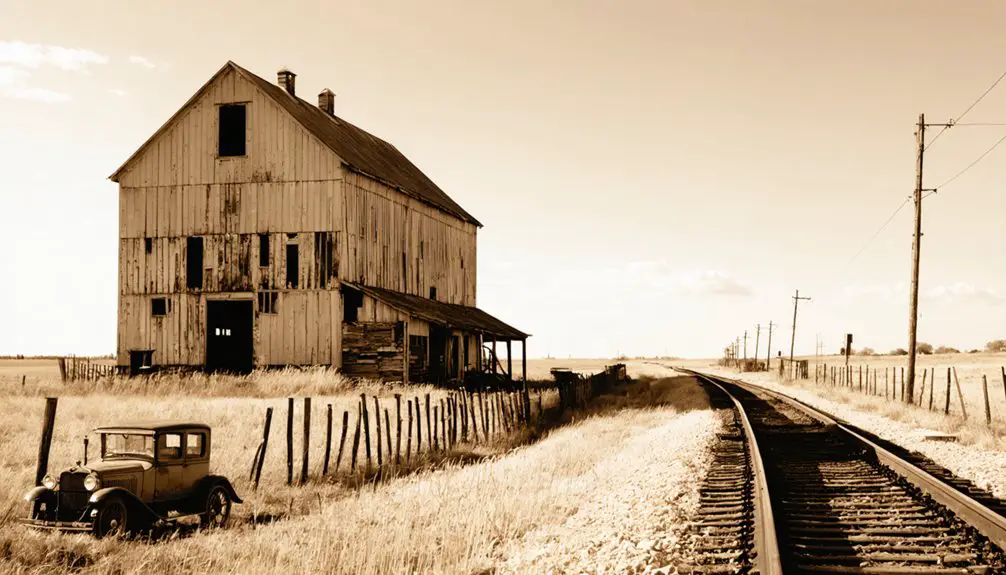
In early 20th century Krem, you’d find daily commerce centered around essential businesses like the general store and grain elevator, where farmers traded crops and purchased supplies for their homesteads.
You’d witness community members gathering regularly at the local schoolhouse and churches, which served as cultural hubs for social activities and celebrations throughout the agricultural seasons.
Local trade networks strengthened as the railroad connected Krem’s residents to broader markets, allowing them to ship grain and livestock while accessing goods from larger towns like Washburn and Devils Lake.
Daily Commerce and Trade
As Krem emerged as a commercial hub in 1902, Martin Netzer established the town’s first general store, setting the foundation for what would become a vibrant trading center.
When William Richter opened a competing store in 1903, their commercial rivalry sparked Krem’s transformation into Mercer County’s bustling trade hotspot.
You’d find these essential elements of Krem’s daily commerce:
- Wheat farming drove the local economy, with varieties like Red Fife and durum supporting the town’s flour mills.
- Trade networks connected through Mercer County guaranteed a steady flow of farming tools and household goods.
- General stores competed to provide settlers with diverse merchandise, from food staples to agricultural equipment.
Community Social Gatherings
Life in early 20th century Krem revolved around vibrant community gatherings, where German-Russian immigrants maintained their cultural identity through traditional celebrations and social events.
You’d find the heart of community bonding at the general stores, which served as social hubs for news, discussions, and public meetings.
During winter months, when farming activities slowed, you’d join your neighbors for storytelling, folk dancing, and music celebrations that preserved cherished cultural traditions.
Religious services, whether Lutheran or Catholic, anchored the social calendar alongside seasonal festivities and feast days.
Despite harsh prairie conditions and relative isolation, you’d participate in barn dances, picnics, and informal sports.
These gatherings weren’t just about entertainment – they strengthened the bonds of this close-knit settlement while helping residents preserve their European heritage in their new American home.
Railroad Impact and the Rise of Hazen
The Northern Pacific Railroad‘s decision to bypass Krem in 1914 dramatically reshaped Mercer County’s development.
When the railroad established its Mandan-Killdeer Branch line eight miles south, it sealed Krem’s fate while birthing the new town of Hazen in 1913.
The railroad’s choice created immediate settlement patterns that would permanently alter the region’s future.
One railroad route decision shaped decades of settlement, forever changing which communities would thrive and which would vanish.
The consequences of this decision manifested in three major ways:
- Residents physically moved their buildings from Krem to Hazen.
- Businesses and services rapidly shifted to the rail-connected location.
- Krem’s flour mill and other industries lost viability without rail access.
You’ll find this change wasn’t merely about transportation – it represented a complete economic and social transformation.
Hazen quickly emerged as the area’s dominant town, while Krem faded into abandonment, showcasing how railroad decisions could make or break frontier communities.
Like many other communities, Krem’s decline reflected a broader pattern where hard times in 1930s forced numerous North Dakota towns into abandonment.
The Path to Abandonment
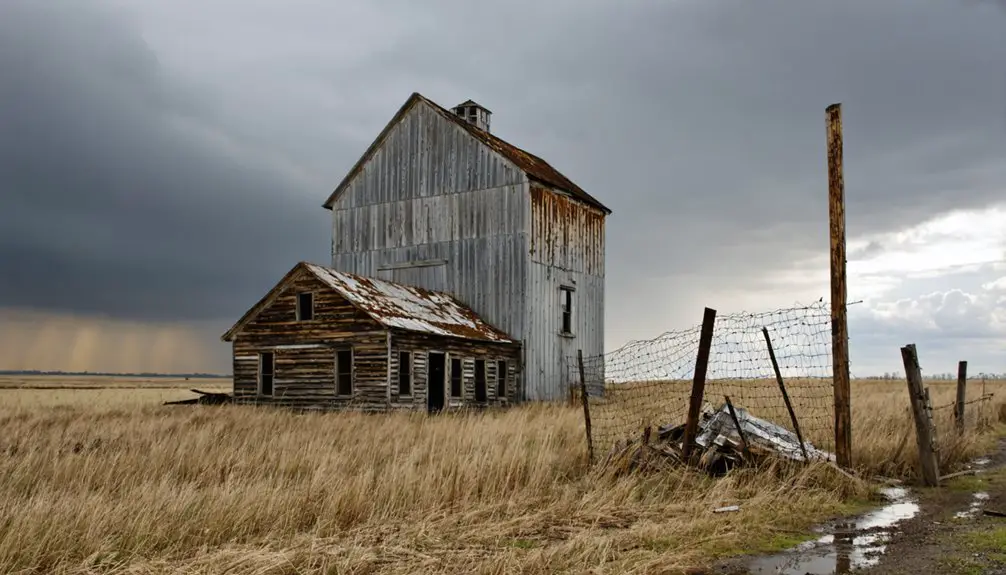
Once Northern Pacific Railroad bypassed Krem in 1913, residents and business owners quickly recognized their town’s grim future.
You’d have witnessed stores and families relocating to Hazen, just 8 miles south, where the railroad promised better opportunities and modern infrastructure. The new town of Hazen was founded that same year, hastening Krem’s decline.
The abandonment factors snowballed throughout the following decades. Major economic decline set in as the post office on Carl Semmler’s farm closed, and the town’s flour mill – once essential to local grain processing – was dismantled in the early 1930s. Like many towns that would become true ghost towns, Krem’s population eventually dropped to zero.
The tight-knit German-Russian community that had given Krem its identity gradually dissolved as social and commercial activities ceased. By mid-century, you wouldn’t have found a single resident remaining.
Today, only two cemeteries and mill remnants mark where this once-promising town stood.
Legacy and Remnants of a Lost Town
Standing silently on North Dakota’s prairie landscape, Krem’s physical remnants tell a poignant story of immigrant dreams and economic hardship.
You’ll find the old flour mill wall and scattered basement foundations marking where businesses once thrived before relocating to nearby Hazen. The town’s immigrant heritage lives on through two historic cemeteries that chronicle the German-Russian settlers who built this community.
Crumbling foundations and weathered headstones tell the story of Krem’s German-Russian pioneers, their dreams preserved in these North Dakota plains.
- The cemeteries’ religious divisions reflect diverse faith groups including Missouri Synod Lutherans, ELCA Lutherans, Methodists, and Catholics.
- Building ruins and photographs document key establishments like the Krem Roller Mill, Netzer Store, and Post Office.
- The cemetery’s significance extends beyond burial grounds, providing essential genealogical records of the German-Russian families who shaped Krem’s identity.
Frequently Asked Questions
Are There Any Surviving Descendants of Original Krem Settlers Still in the Area?
You’ll find most Krem descendants relocated to Hazen after 1913, though there’s no confirmed record of original Krem settlers’ families still living directly in the abandoned town area today.
What Did the Town’s Main Street Look Like During Its Peak Years?
In 1903, you’d see two competing general stores, a towering 4-story flour mill, a creamery, and post office lining your path down a bustling dirt road serving countless German-Russian settlers.
Did Any Famous People or Notable Historical Events Occur in Krem?
You’ll find Krem’s history marked by the 1933 tornado that destroyed St. James’ Lutheran Church, the courthouse battle of 1906, and local legends like Martin Netzer, who founded the town’s first store.
What Natural Disasters Besides Tornadoes Affected Krem Throughout Its History?
You’ll find severe flood damage hit the area repeatedly, especially in 1897, 1997, and 2011. Drought impact devastated local farms in the 1920s-30s, and harsh winter storms frequently isolated the community.
Can Visitors Legally Explore the Remaining Ruins of Krem Today?
You can’t legally explore Krem’s ruins without landowner permission since it’s on private property. Ghost town regulations require consent, and visitor safety depends on respecting these property boundaries.
References
- https://news.prairiepublic.org/main-street/2019-11-07/krem-a-ghost-county-seat
- https://travelingwithtom.com/my-home-town-hazen-north-dakota/
- https://ghostsofnorthdakota892857007.wordpress.com/2015/10/30/true-ghost-towns-population-zero/
- https://www.history.nd.gov/archives/manuscripts/inventory/2018-P-055.html
- https://www.ghosttowns.com/states/nd/krem.html
- https://en.wikipedia.org/wiki/History_of_North_Dakota
- https://www.history.nd.gov/ndhistory/settlement.html
- https://commons.und.edu/context/oers/article/1000/viewcontent/History_of_ND_FinalPDF.pdf
- http://sites.rootsweb.com/~ndmercer/history.htm
- https://www.ndstudies.gov/gr4/early-settlement-north-dakota/part-3-north-dakota-pioneers/section-1-pioneer-life
